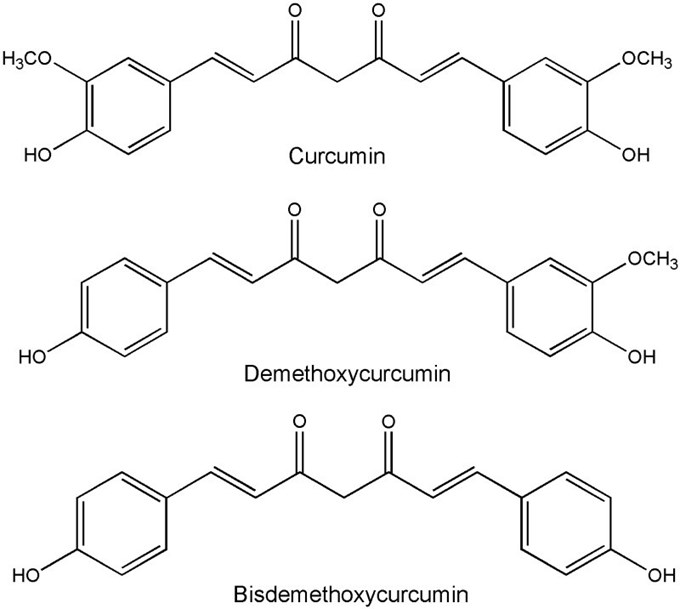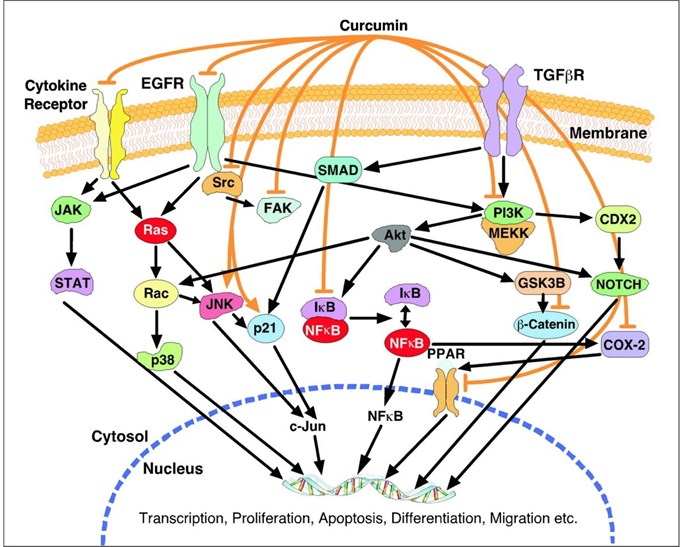1. Introduction
Turmeric is a spice that has received much interest from both the medical/scientific worlds as well as from the culinary world. Turmeric is a rhizomatous herbaceous perennial plant (Curcuma longa) of the ginger family [1]. The medicinal properties of turmeric, the source of curcumin, have been known for thousands of years; however, the ability to determine the exact mechanism(s) of action and to determine the bioactive components have only recently been investigated [2]. Curcumin (1,7-bis(4-hydroxy-3-methoxyphenyl)-1,6-heptadiene-3,5-dione), also called diferuloylmethane, is the main natural polyphenol found in the rhizome of Curcuma longa (turmeric) and in others Curcuma spp. [3]. Curcuma longa has been traditionally used in Asian countries as a medical herb due to its antioxidant, anti-inflammatory [4], antimutagenic, antimicrobial [5,6], and anticancer properties [7,8].
Curcumin, a polyphenol, has been shown to target multiple signaling molecules while also demonstrating activity at the cellular level, which has helped to support its multiple health benefits [2]. It has been shown to benefit inflammatory conditions [9], metabolic syndrome [10], pain [11], and to help in the management of inflammatory and degenerative eye conditions [12,13]. In addition, it has been shown to benefit the kidneys [14].
Curcumin is being recognized and used worldwide in many different forms for multiple potential health benefits. For example, in India, turmeric—containing curcumin—has been used in curries; in Japan, it is served in tea; in Thailand, it is used in cosmetics; in China, it is used as a colorant; in Korea, it is served in drinks; in Malaysia, it is used as an antiseptic; in Pakistan, it is used as an anti-inflammatory agent; and in the United States, it is used in mustard sauce, cheese, butter, and chips, as a preservative and a coloring agent, in addition to capsules and powder forms. Curcumin is available in several forms including capsules, tablets, ointments, energy drinks, soaps, and cosmetics [2]. Curcuminoids have been approved by the US Food and Drug Administration (FDA) as “Generally Recognized As Safe” (GRAS) [2], and good tolerability and safety profiles have been shown by clinical trials, even at doses between 4000 and 8000 mg/day [15] and of doses up to 12,000 mg/day of 95% concentration of three curcuminoids: curcumin, bisdemethoxycurcumin, and demethoxycurcumin [16]
    |
 |
| Figure 1: Chemical structure of curcuminoids (include curcumin, demethoxycurcumin, and bisdemethoxycurcumin) |
2. Health Effects of Curcumin
2.1. Anti-Inflammatory Mechanism of Curcumin
The inflammatory pathway consists of four parts: inducers, sensors, mediators and effectors. The physiological and pathological mechanisms of inflammation caused by different Inflammatory triggers are different and have not yet been clarified [17]. In general, the anti-inflammatory effects of drugs mainly include: acting on receptors and signaling pathways, regulating the response of target tissues to inflammatory mediators; reversing the effect of the medium on the target tissue; producing anti-inflammatory mediators, and so on [18]. Curcumin exerts anti-inflammatory effects by regulating inflammatory signaling pathways and inhibiting the production of inflammatory mediators (Figure 2).
    |
 |
| Figure 2: The regulatory effect of curcumin on inflammatory signaling pathway. |
2.2. The effect of Curcumin on Cancer Treatment
Curcumin has been found to affect cancer cells in a variety of ways leading to the prevention of cancer formation. Its most prominent effects on cancer are summarized in Figure 3 and Figure 4
v Lung cancer: Curcumin exhibits its therapeutic potential in lung cancer treatment by acting on the Wnt/β-catenin-dependent pathway in the human lung cancer cell line A549 [19]. Curcumin also suppresses the vascular endothelial growth factor (VEGF0 and NF-κB expression in the same cell line [20]. In addition, curcumin has been shown to inhibit the expression of enhancer of zeste homolog 2 (EZH2) in lung cancer cells, which was followed by a decrease in the expression of the Notch 1 gene [21]. Curcumin also induces ROS production, thus activating the DNA damage signaling pathway [22].
v Breast Cancer: Curcumin was found to inhibit the phosphorylation of Akt, mTOR and their downstream proteins, resulting in cell cycle arrest of various breast cancer cell lines, including T47D and MCF7 [23].
v Prostate Cancer: everal in vitro studies have identified curcumin as an effective agent in the treatment of prostate cancer. Curcumin interferes with various molecular signaling pathways, including the NF-κB, mitogen-activated protein kinase (MAPK) and epidermal growth factor (EGFR) pathways [63]. Moreover, curcumin downregulates C-X-C motif chemokine ligand 1 (CXCL-1) and CXCL-2 by targeting the NF-κB pathway in androgen independent prostate cancer (AIPC) cells [24].
v Gastric Cancer: Recent evidence indicates promising anticancer effects of curcumin via its ability to inhibit several signal transduction pathways, such as the p53, Ras, Wnt-β, extracellular signal-regulated kinases (ERK), PI3K, MAPKs and protein kinase B (Akt) in gastric cancer cells [25].
    |
 |
| Figure 4: Oncogenic signaling targets many levels curcumin |
References
1. Priyadarsini, K.I. The chemistry of curcumin: From extraction to therapeutic agent. Molecules 2014, 19, 20091–20112.
2. Gupta, S.C.; Patchva, S.; Aggarwal, B.B. Therapeutic Roles of Curcumin: Lessons Learned from Clinical Trials. AAPS J. 2013, 15, 195–218.
3. Aggarwal, B.B.; Kumar, A.; Bharti, A.C. Anticancer potential of curcumin: Preclinical and clinical studies. Anticancer Res. 2003, 23, 363–398.
4. Lestari, M.L.; Indrayanto, G. Curcumin. Profiles Drug Subst. Excip. Relat. Methodol. 2014, 39, 113–204.
5. Mahady, G.B.; Pendland, S.L.; Yun, G.; Lu, Z.Z. Turmeric (Curcuma longa) and curcumin inhibit the growth of Helicobacter pylori, a group 1 carcinogen. Anticancer Res. 2002, 22, 4179–4181.
6. Reddy, R.C.; Vatsala, P.G.; Keshamouni, V.G.; Padmanaban, G.; Rangarajan, P.N. Curcumin for malaria therapy. Biochem. Biophys. Res. Commun. 2005, 326, 472–474.
7. Vera-Ramirez, L.; Perez-Lopez, P.; Varela-Lopez, A.; Ramirez-Tortosa, M.; Battino, M.; Quiles, J.L. Curcumin and liver disease. Biofactors 2013, 39, 88–100.
8. Wright, L.E.; Frye, J.B.; Gorti, B.; Timmermann, B.N.; Funk, J.L. Bioactivity of turmeric-derived curcuminoids and related metabolites in breast cancer. Curr. Pharm. Des. 2013, 19, 6218–6225.
9. Aggarwal, B.B.; Harikumar, K.B. Potential therapeutic effects of curcumin, the anti-inflammatory agent, against neurodegenerative, cardiovascular, pulmonary, metabolic, autoimmune and neoplastic diseases. Int. J. Biochem. Cell Biol. 2009, 41, 40–59.
10. Panahi, Y.; Hosseini, M.S.; Khalili, N.; Naimi, E.; Simental-Mendia, L.E.; Majeed, M.; Sahebkar, A. Effects of curcumin on serum cytokine concentrations in subjects with metabolic syndrome: A post-hoc analysis of a randomized controlled trial. Biomed. Pharmacother. 2016, 82, 578–582.
11. Kuptniratsaikul, V.; Dajpratham, P.; Taechaarpornkul, W.; Buntragulpoontawee, M.; Lukkanapichonchut, P.; Chootip, C.; Saengsuwan, J.; Tantayakom, K.; Laongpech, S. Efficacy and safety of Curcuma domestica extracts compared with ibuprofen in patients with knee osteoarthritis: A multicenter study. Clin. Interv. Aging 2014, 9, 451–458.
12. Mazzolani, F.; Togni, S. Oral administration of a curcumin-phospholipid delivery system for the treatment of central serous chorioretinopathy: A 12-month follow-up study. Clin. Ophthalmol. 2013, 7, 939–945.
13. Allegri, P.; Mastromarino, A.; Neri, P. Management of chronic anterior uveitis relapses: Efficacy of oral phospholipidic curcumin treatment. Long-term follow-up. Clin. Ophthalmol. 2010, 4, 1201–1206.
14. Trujillo, J.; Chirino, Y.I.; Molina-Jijón, E.; Andérica-Romero, A.C.; Tapia, E.; Pedraza-Chaverrí, J. Renoprotective effect of the antioxidant curcumin: Recent findings. Redox Biol. 2013, 1, 448–456.
15. Basnet, P.; Skalko-Basnet, N. Curcumin: An anti-inflammatory molecule from a curry spice on the path to cancer treatment. Molecules 2011, 16, 4567–4598.
16. Lao, C.D.; Ruffin, M.T.; Normolle, D.; Heath, D.D.; Murray, S.I.; Bailey, J.M.; Boggs, M.E.; Crowell, J.; Rock, C.L.; Brenner, D.E. Dose escalation of a curcuminoid formulation. BMC Complement. Altern. Med. 2006, 6, 10.
17. Medzhitov R. Origin and physiological roles of inflammation. Nature. 2008;454(7203):428–435. doi: 10.1038/nature07201.
18. Medzhitov R. Inflammation 2010: new adventures of an old flame. Cell. 2010;140(6):771–776. doi: 10.1016/j.cell.2010.03.006.
19. Wang J.W., Wang X., Wang X.J., Zheng B.Z., Wang Y., Liang B. Curcumin inhibits the growth via Wnt/β-catenin pathway in non-small-cell lung cancer cells. Eur. Rev. Med. Pharmacol. Sci. 2018;22:7492–7499.
20. Li X., Ma S., Yang P., Sun B., Zhang Y., Sun Y., Hao M., Mou R., Jia Y. Anticancer effects of curcumin on nude mice bearing lung cancer A549 cell subsets SP and NSP cells. Oncol. Lett. 2018;16:6756–6762. doi: 10.3892/ol.2018.9488.
21. Wu G.Q., Chai K.Q., Zhu X.M., Jiang H., Wang X., Xue Q., Zheng A.H., Zhou H.Y., Chen Y., Chen X.C., et al. Anti-cancer effects of curcumin on lung cancer through the inhibition of EZH2 and NOTCH1. Oncotarget. 2016;7:26535–26550. doi: 10.18632/oncotarget.8532.
22. Wang C., Song X., Shang M., Zou W., Zhang M., Wei H., Shao H. Curcumin exerts cytotoxicity dependent on reactive oxygen species accumulation in non-small-cell lung cancer cells. Future Oncol. 2019;15:1243–1253.
23. Shan H., Yingchun X., Liwei M., Liming H., He S. Curcumin inhibits proliferation and promotes apoptosis of breast cancer cells. Exp. Ther. Med. 2018;16:1266–1272.
24. Killian P.H., Kronski E., Michalik K.M., Barbieri O., Astigiano S., Sommerhoff C.P., Pfeffer U., Nerlich A.G., Bachmeier B.E. Curcumin inhibits prostate cancer metastasis in vivo by targeting the inflammatory cytokines CXCL1 and-2.Carcinogenesis. 2012;33:2507–2519. doi: 10.1093/carcin/bgs312.
25. Kasi P.D., Tamilselvam R., Skalicka-Woźniak K., Nabavi S.F., Daglia M., Bishayee A., Pazoki-Toroudi H., Nabavi S.M. Molecular targets of curcumin for cancer therapy: An updated review. Tumor Biol. 2016;37:13017–13028. doi: 10.1007/s13277-016-5183-y.
Hoang Viet Giang